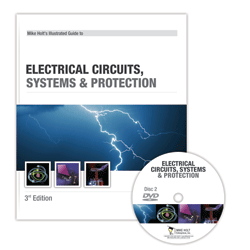Available Short-Circuit Current
By Mike Holt, Published in EC&M Magazine
Available short-circuit current (SCA) is the current in amperes that is available at a given point in the electrical system. This available short current is first determined at the secondary terminals of the utility transformer. Thereafter the available short-circuit current is calculated at the terminals of the service equipment, branch circuit panel and branch circuit load.
The available short-circuit current is different at each point of the electrical system; it is highest at the utility transformer and lowest at the branch circuit load. The available short-circuit current is dependent on the impedance of the circuit, which increases downstream from the utility transformer. The greater the circuit impedance (utility transformer and the additive impedances of the circuit conductors) the lower the available short-circuit current.
Factors that impact the available short-circuit current at the utility transformer include the system voltage, the transformer kVA rating and its impedance (as expressed in a percentage). Properties that impact the impedance of the circuit include the conductor material (copper versus aluminum), the conductor size, and it's length.
Author's Comment: The impedance of the circuit increases the further from the utility transformer, therefor the available short-circuit current is lower downstream from the utility transformer.
Interrupting Rating. Overcurrent protection devices such as circuit breakers and fuses are intended to interrupt the circuit and they must have an ampere interrupting rating (AIR) sufficient for the available short-circuit current in accordance with Sections 110-9 and 240-1. Unless marked otherwise, the ampere interrupting rating for branch-circuit circuit breakers is 5,000 ampere [240-83(c)] and 10,000 ampere for branch-circuit fuses [240-60(c)].
Extremely high values of current flow (caused by short-circuits or line-to-ground faults) produce tremendous destructive thermal and magnetic forces. If the circuit overcurrent protection device is not rated to interrupt the current at the available fault values, it could explode while attempting to clear the fault. Naturally this can cause serious injury, death as well as property damage.
Protection of Electrical Components. In addition to interrupting rating for overcurrent devices, electrical equipment, components, and circuit conductors must have a short-circuit current (withstand) rating that will permit the circuit overcurrent protective device to clear a fault without extensive damage to any of the components of the electrical system [110-9, 110-10, 250-2(d), 250-90, 250-96(a) and Table 250-122 Note].
If the available short-circuit current exceeds the equipment/conductor short-circuit current rating, then the thermal and magnetic forces can cause the equipment to explode and/or the circuit conductors as well as grounding conductors to vaporize. The only solution to the problem of excessive available fault current is to
(1) Install equipment that has a higher short-circuit rating
(2) Protect the components of the circuit by a current-limiting protection device such as a fast-clearing fuse, which can reduce the let-thru energy.
| Get Up to Speed Quickly with the Latest Information | |

|
This volume covers the electrical theory areas of series circuits, parallel circuits, series-parallel circuits, multiwire circuits, the electrical system, and protection devices. You'll learn how a fuse differs from a circuit breaker, how to select a circuit breaker, and what makes it work. You'll understand the role of circuit overcurrent protection in clearing ground faults and some critical facts about grounding. More Information |






 Products
Products Cart
Cart